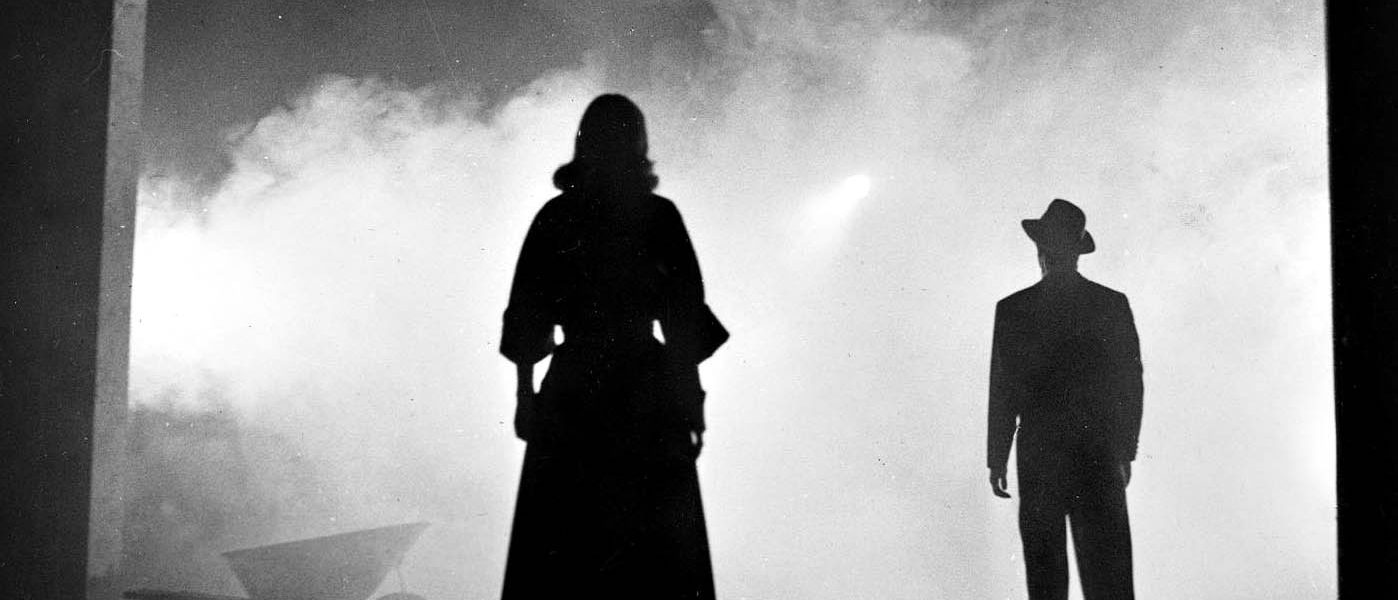A Slightly Obsessed Genre Special!
OVERVIEW
Back in 2013 I started a weekly, self-imposed discipline of movie write-ups on my Facebook page. My intent—besides meagerly attempting, admittedly, to self-justify half a lifetime of obsessive movie-watching—was to find a format for writing about movies that is both entertaining and informative. Basically, I thought that if I could in any way pique a theoretical reader’s interest in classic movies or movie history, then I would consider the modest venture a rousing success.
Over this four week period, then, I’ll be rolling out the very first from these “series” on classic movies which I’ve here re-named “American Genres.” Identifying four distinct, uniquely homegrown categories of American filmmaking, I trace the chronology—in terms of convention and thematic content, mainly, but also in terms of their historical development—through eight “key” examples from each chosen genre.
While by no means an exhaustive survey or a rigorously-academic analysis, these are rather brief, hopefully engaging and accessible essays—written from the vantage of being a movie ‘enthusiast’ as opposed to a ‘writer’ or ‘critic’—on some of my personal favorite movies.
INTRO: FILM NOIR!
Film Noir: Early Days
Dimming the lights, bleeding the image to the ashen tones of black & grey, and ratcheting up the tension on a ten-scale to ’11,’ I’ll be reserving the next few spaces on this column for chiaroscuro visions of madness, mayhem, and murder. “Down these mean streets a man must go, [untarnished and unafraid]” went the call of a new type of hero for a new world: the world of FILM NOIR.
Mixing the shadowy atmosphere of the post-WWI German Art Film—and its immediate descendant, the Hollywood horror movie—with the crime and gangster docudramas of the 1930s, studios and filmmakers plundered the works of hardboiled mystery writers like Dashiell Hammett, Raymond Chandler, and James M. Cain in visualizing the darker aspects of contemporary American life, full-frontally attacking such thematic material as lust, greed, desperation, revenge…
As the flip side to the Technicolor dreams of the Great Movie Musicals, the film noir explicates the American Nightmare.
But hey, they’re entertaining too. Featuring the tersest, stripped-down dialogue the very best among Hollywood wordsmiths had to offer—along with breakneck-paced, time-skewering plotting and vertiginous, virtuoso visual stylistics—even the cheapest “guy, girl, and a gun” melodrama is eminently, compulsively watchable. A guy in a hat reading the paper in a bare little office space may be lazy filmmaking, but stream a little light through some Venetian blinds on that same guy in that same hat reading that same paper and you’ve got ART.
I.
DOUBLE INDEMNITY
(1944, Paramount, dir. Billy Wilder)
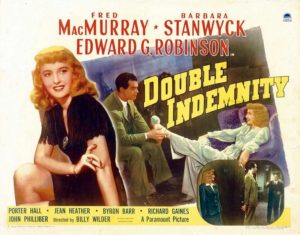 In Los Angeles of the late 1930s, a smart-talking insurance guy (Fred MacMurray) calls on a hacienda-style house in the Hollywood Hills to renew an auto insurance policy. The man of the house isn’t in, but his wife (Barbara Stanwyck) greets him from the top of the stairs in a bath towel and, after going back to her bedroom to dress, saunters slowly down the staircase. Sparks fly. (“That’s a honey of an ankle bracelet, Mrs. Dietrichson.”) After trading a few more innuendo-laced barbs, Neff leaves the Dietrichson house almost not having realized he’s been suckered into drawing up an accident insurance policy without the husband’s knowledge. (“Read: MURDER.”) But he’s still got that ankle bracelet on his mind, along with the smell of honeysuckle…
In Los Angeles of the late 1930s, a smart-talking insurance guy (Fred MacMurray) calls on a hacienda-style house in the Hollywood Hills to renew an auto insurance policy. The man of the house isn’t in, but his wife (Barbara Stanwyck) greets him from the top of the stairs in a bath towel and, after going back to her bedroom to dress, saunters slowly down the staircase. Sparks fly. (“That’s a honey of an ankle bracelet, Mrs. Dietrichson.”) After trading a few more innuendo-laced barbs, Neff leaves the Dietrichson house almost not having realized he’s been suckered into drawing up an accident insurance policy without the husband’s knowledge. (“Read: MURDER.”) But he’s still got that ankle bracelet on his mind, along with the smell of honeysuckle…
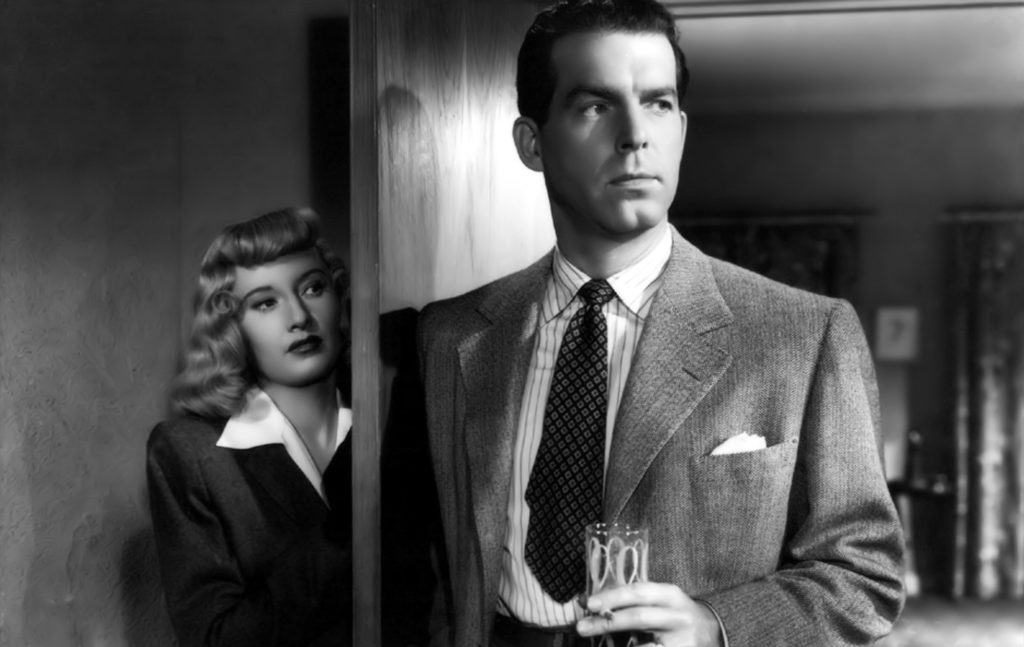
“Hold tight to that cheap cigar of yours, Keyes: I killed Dietrichson. Me, Walter Neff, 35 years old, insurance agent, unmarried, no visible scars—until a little while ago, that is.”
Lust, greed, murder, betrayal. For his third movie as director, former screenwriter Billy Wilder found himself in a fortuitous position: Paramount had acquired rights for him to a ‘hot’ novel by James M. Cain featuring liberal quantities of sex and violence (and whose previous novella, “The Postman Always Rings Twice,” had proved unadaptable by standards of Hollywood decency to that point; despite the studio bidding frenzy it had inspired); he had again secured the services of cinematographer John F. Seitz, whose Citizen Kane-like experiments with depth-composition and light-shading on their previous film, Five Graves to Cairo (1943), evoked the nightworld atmosphere of German-made art films Vienna-born Wilder grew up on; and, finally, then-recovering alcoholic crime novelist, Raymond Chandler, was brought on to punch-up the dialogue. (Apologies for that trainwreck of a run-on sentence there, so here’s a sampling of that stripped-to-the-bone dialogue as compensation… PHYLLIS: “We’re both rotten.” WALTER: “Only you’re a little more rotten.”)
The lattermost collaboration may have served to send the notoriously prickly Chandler back off the wagon—along with perhaps inspiring Billy Wilder to contemplate the title of Chandler’s famous essay, “The Simple Art of Murder,” more than once—but it resulted in a tightly-plotted, blisteringly-intense screenplay where the innuendo was laid thick and the words were wielded like blunt objects. Yes, there had been thrillers with a similar degree of noir-ish intensity inspired by the towering standard set by 1941’s The Maltese Falcon (Stranger on the Third Floor [1940] and I Wake Up Screaming[1941] being two other notable early examples), but as a story grounded in everyday reality—I mean, the details in Neff’s confession above could describe the writer of this essay on at least 3 points—combined with the flamboyant stylistic atmosphere of art-inspired photography, this *may* have been the first true crime thriller in which story and image were so successfully and symbiotically aligned. The first true noir.
And I didn’t even mention the casting! Fred MacMurray—formerly a light romantic lead and later a star of family sitcoms and Disney movies—plays brilliantly against type here as an over-ambitious insurance man choked-to-the-gills by sexual desire and Barbara Stanwyck is absolutely frightening as a black widow whose cunning is only matched by her ruthlessness. (For this role, she’s frequently singled out as one of the greatest female screen villains of all-time.) But the real laurels here go to Edward G. Robinson, the “Little Caesar” of ’30s gangster flicks, as claims adjuster “Barton Keyes”—the most unlikely of screen detectives who acts on intuitions based on chronic indigestion (“The ‘little man’ was acting up on me again”) and who is always short of thumb-flicked matches to light his nickel cigars. And I mention that last part about offering the match ‘cause it’s the very motif by which the one redeeming moment of tenderness is enacted in the closing seconds of the film, giving special resonance to the phrase, “I love you too.” This is maybe the only time—in fiction or life—where you might actually believe it!
II.
OUT OF THE PAST
(1947, RKO, dir. Jacques Tourneur)
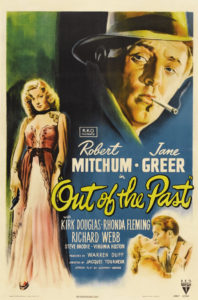 A large man in a dark trench coat (Paul Valentine) pulls up to a gas station while driving through the backwoods of Northern California. He’s looking for the owner of the gas station, “Jeff Bailey” (Robert Mitchum). Bailey has changed his name, and built up a new life for himself–with a nice girl (Virginia Huston) and a deaf and dumb kid he looks out for (Dickie Moore)–but the past has finally caught up with him in the form of a hulking, soft-spoken underworld henchman with a message. Seems an old ‘employer’ wants to get in touch with Bailey over a little unresolved matter of $40,000…
A large man in a dark trench coat (Paul Valentine) pulls up to a gas station while driving through the backwoods of Northern California. He’s looking for the owner of the gas station, “Jeff Bailey” (Robert Mitchum). Bailey has changed his name, and built up a new life for himself–with a nice girl (Virginia Huston) and a deaf and dumb kid he looks out for (Dickie Moore)–but the past has finally caught up with him in the form of a hulking, soft-spoken underworld henchman with a message. Seems an old ‘employer’ wants to get in touch with Bailey over a little unresolved matter of $40,000…
Y’see, years ago, back when he was still known as “Jeff Markham,” Bailey was hired by big-time gambler “Whit” (Kirk Douglas) to trail Whit’s girlfriend, “Kathie Moffat” (Jane Greer), whom Whit claims shot him for dead and ran off with a big chunk of his change. $40,000, to be precise. As Markham, Bailey was a particularly gifted gumshoe and quickly found the disappearing dame in sunny Acapulco. Kathie claims innocence, which Markham finds easy to believe when staring into her dark eyes and sun-blinded by her white dress…
So they ran off together, Kathie claiming eternal devotion. Only it didn’t last: Kathie dropped Markham cold when things got too hot, Markham discovered Kathie was capable of cold-blooded murder, and, finally, Markham found himself taking the heat for the cold forty grand, which it turns out Kathie had all along…
Now it’s several years later, Markham has become Bailey, and he’s entering the dining room of Whit’s estate on Lake Tahoe, when whom should he see casually dining on a deviled egg opposite Whit but Kathie! Even ever-cool Markham/Bailey(/Mitchum) registers surprise…
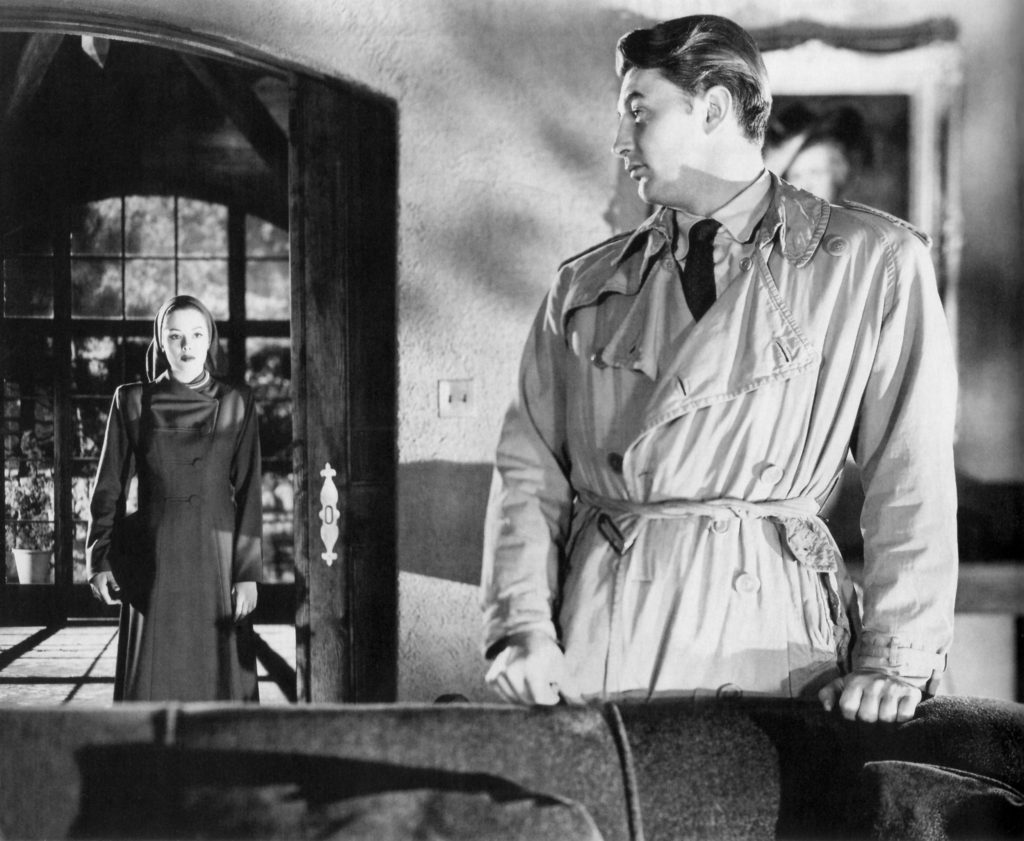
“All women are wonders because they reduce all men to the obvious.”
“Build my gallows high, baby.”
Well, that’s just the quarter of it, but suffice it to say that it doesn’t end well. For anyone. The complicated plot-making is half the point of a good noir and, as this is one of the best, perhaps it is entirely appropriate that what follows, plot-wise, has stymied even the most perceptive viewers. (And certainly this one.)
Where/why was bookmaker “Leonard Eels” (Ken Niles) killed and how did Whit and/or Kathie expect to pin it on Markham? (Indeed, was it Whit OR Kathie who ordered Eels’ death?) What’s the deal with Whit’s tax records and how does Markham know to find them in a random office in a specific drawer at one among presumably many of Whit’s clubs? And sure, one imagines that Markham/Bailey is playing along just to stay alive (to a point, that is), but what’s Whit’s game, exactly? More importantly, what’s Kathie’s?
And it’s that gaping black hole at the center of these complicated and convoluted goings-on that proves the most disturbing aspect to this Greek tragedy of crushing fate, ever-mounting levels of betrayal, and murder most foul. Every good noir needs a villain and, again, as this is one of the best, the best noir villains are usually women. The femme fatale.
Don’t know whether this makes more of a case for there having been strong roles for women in classic Hollywood movies or evidence of bitter misogyny on the part of their (mostly) male writers, but I’m personally inclined towards the former view. “Crazy,” and possibly borderline, is how many commentators describe the character—and I am, again, inclined to agree—but still, there’s something kinda satisfying in watching events unfold at the sole instigation of a character who so successfully manipulates events/people to her murky ends.
The dark pleasures of the darkling dame!
Director Jacques Tourneur—whom French critic (and later writer/director) Francois Truffaut dubbed “the poet of nightfall”—provides a brooding, sinister atmosphere resplendent in the shadowy compositions of frequent collaborator, cinematographer Nicholas Musuraca. (According to Wikipedia, the late critic Roger Ebert called this “the greatest cigarette-smoking movie” for its wispy, snake-curling tendrils of smoke that hang like a choking miasma over each scene/set.)
Based on a book by screenwriter Daniel Mainwaring (writing under “Geoffrey Homes”), whose original title provides one of the searing quotes preceding this write-up, OUT OF THE PAST—with uncredited contributions from roman noir writers Frank Fenton and James M. Cain—is yet another example of a twisty-turny, time-tweaking crime melodrama soaked in the smoky, shadow-bathed atmosphere of A+ Hollywood filmmaking. A true noir classic.
III.
SUNSET BLVD
(1950, Paramount, dir. Billy Wilder)
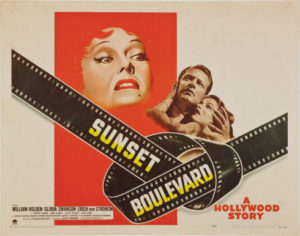 [over phone] Times City Desk? This is Hedda Hopper [herself] speaking. Don’t bother with a rewrite man, take this direct… Ready?
[over phone] Times City Desk? This is Hedda Hopper [herself] speaking. Don’t bother with a rewrite man, take this direct… Ready?
“As day breaks over the murder scene, Norma Desmond [Gloria Swanson], famed star of the silent screen, sits in the boudoir of her home on Sunset Boulevard in a state of complete mental shock. Surrounded by police officers, newspaper reporters, and photographers, Ms. Desmond is entirely oblivious to the barrage of questions fired at her by Captain Parker of the L.A. Homicide Squad.
“Rather, she stares blankly into a mirror—head held high, defiant—waiting to be called back to life by the millions of fans who deserted her. Is this 1927? Will the cameras roll once more for Norma Desmond? The lingering spell of riotous orgies and moonlight tangos lays thick within the crumbling mansion as her Teutonic manservant, Max [Erich von Stroheim], stands faithfully in attendance, leaning over to tell his mistress that ‘Mr. DeMille’ [himself] is even now preparing her final close-up…”
“But what of the young man floating in the Olympic-sized swimming pool [William Holden], two bullets in his back and one in his belly? A screenwriter with a few B pictures to his credit, one can only assume a June-October arrangement so common in these Hollywood Hills gone disastrously wrong. But until we are privy to the full story—and perhaps we never shall be—we are left only to imagine the details that lifeless body could relate about this remarkable woman in her dream palace of yesteryear, long after the parade has passed her by.”
End quote, copy, print.
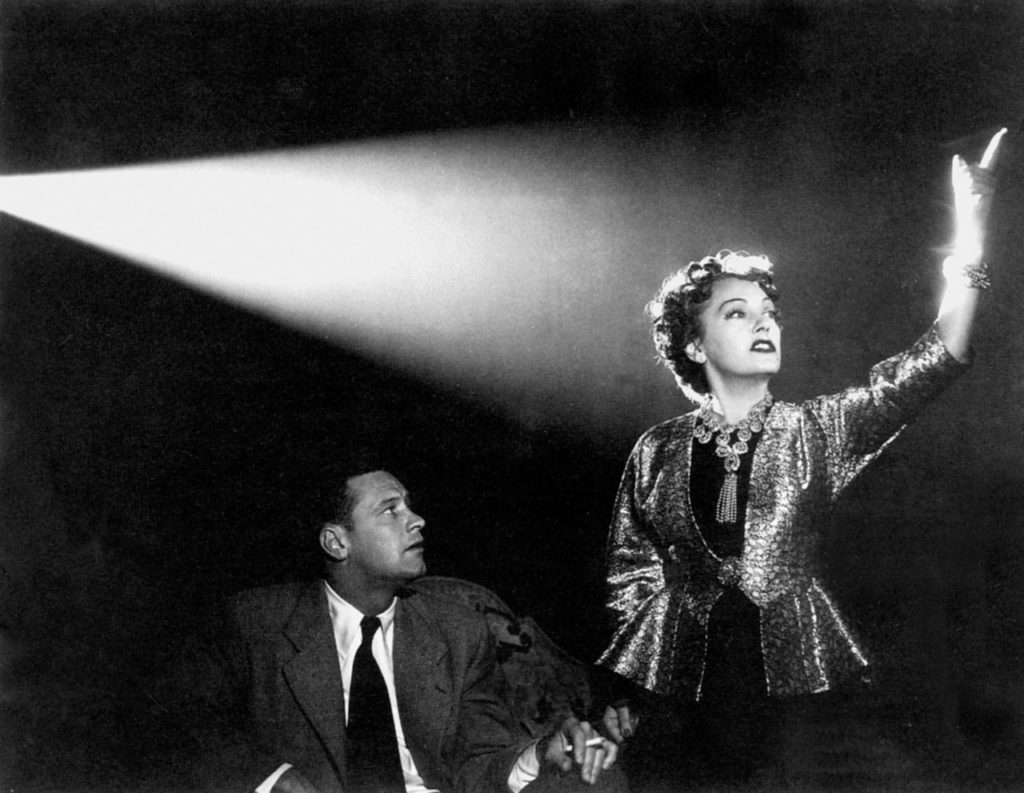
“I am big. It’s the pictures that got small.”
First off, just how cool is it to watch a movie narrated by a corpse? Film critic/novelist James Agee called Billy Wilder & Charles Brackett’s script “cold, exact, adroit [and] sardonic” and the device is/was nothing if not daring. (It certainly freaked out my then-5 year old uncle, who saw this movie with my grandparents and infant mother during its original run!)
Re-teaming with Double Indemnity cinematographer John F. Seitz, the shadowy compositions of film noir evokes the haunted house atmosphere of the spookiest Hollywood fright film, and the delirious effect is made complete by set designer Hans Dreier’s overstuffed interiors—complete with a musty old pipe organ and a library cinema that only shows “her movies”—and Franz Waxman’s distorted musical variations on old ’20s and ’30s movie themes. In its depiction of a faded Hollywood and a mad old movie star, SUNSET BLVD seems almost a grand act of sarcasm, and even after 60 years you kinda wonder how they got away with it as the target of all their bitterness and cynicism was the very business/artistic institution that created it: Hollywood, itself!
Well, I think the answer to that question lies in the brilliant casting of “one of the old greats”—Gloria Swanson—as Norma Desmond, “aging star of the silent screen, yesterday’s glamour queen.” This role, I believe, was rejected by Mae West, Pola Negri, Norma Shearer, Greta Garbo, and Mary Pickford before Wilder & Brackett settled on Swanson. And really, you can’t imagine anyone else in the role after seeing her here. Cold, imperious, theatrical, proud, deluded, funny; Swanson is never less than compelling—and strangely sympathetic—as a woman tragically “enfolded” by the dream of the past. HER past. Yes, because as long as those candle-lit, soft-focus images continue to flicker across the big screen—projected by her former husband/director and now manservant (Erich von Stroheim as “Max,” who actually DID direct that very film—which, as any obsessive movie-watcher will point out, is taken from their never-finished Ruritanian epic, Queen Kelly [1929])—somewhere, somehow, Norma Desmond lives forever.
Film Noir: Mid-Period
If nothing else, the main point I wish to make through these entries is that the style, conventions, and themes of a genre create its own world. Thus far, the “worlds” of screwball, musicals—and here film noir—inherently possess their own distinct, imaginary space, along with a set of codified rules and expectations, for their viewers.
But what happens, then, when those rules don’t seem to apply anymore? When viewers have been down a certain narrative road one too many times? When, indeed, the “world” so carefully-delineated and described no longer seems to exist?
Our mid-selections–beginning in about 1955 and ending around 1960–highlight the passing of an era—the age of noir—and, by extension, its rebirth in an updated setting (our first selection), its re-setting through stylistic innovation and narrative experimentation (our second selection), and even its re-location to another continent (our third selection).
IV.
KISS ME DEADLY
(1955, United Artists, dir. Robert Aldrich)
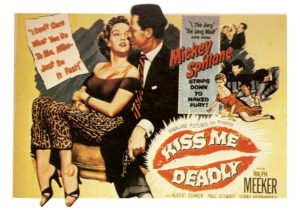 “Remember me.”
“Remember me.”
Remember you? How could I forget… That barefoot dame running down the highway in nothing but a trench coat (Cloris Leachman). Damn near ran me off the road. But I picked her up anyway. Gave her a lift to the nearest gas station, getting an earful of poetry and pop psychology the whole way. Soon found out she’d pulled a runner from the local laughing house, which didn’t surprise me one bit. But something held me back from turning her over to the cops. She was on to something big. Real big. And I only knew just how big after some torpedoes flagged us down and, a jagged slash to the skull later, I was lying on a floor listening to her screams…
Woke up in a hospital with my secretary, Velda (Maxine Cooper), and Lt. Pat Murphy (Wesley Addy) of the L.A. Homicide Squad leaning over. My cop pal asked if I knew who I was. Sure. Mike Hammer’s the name (Ralph Meeker). Jokers crack wise and call me a “bedroom dick” which is a not-so-nice way of saying that I do matrimonial work. Helping couples in trouble, and then stirring a little for myself. But lying there in the hospital, and then being hauled down to the cop shop for “questioning,” I thought I could put all that aside for awhile. I can smell money and trouble a mile off and this dame reeked of it. A big score with a Big Whatsit at the end of it…
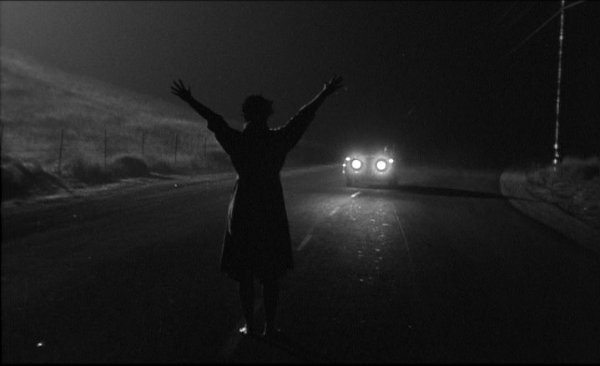
“Kiss me, Mike. I want you to kiss me. The liar’s kiss that says I love you, and means something else.”
Robert Aldrich’s forceful, bitter, violent, sexy—and even apocalyptic!—P.I. saga, based on the novel by Mickey Spillane, comes as a late entry to the genre. You could even say it’s the last true Detective Movie—where gangsters, “heaters bulging from their [vest] pocket[s],” wore trench coats and fedoras, and hatchet-faced crooks planned capers in roadside diners—‘cause the world those movies of the ’40s and early ’50s described was quickly disappearing. Pointedly, the title chosen by the great practitioner of the genre, Raymond Chandler, for his 1953 Philip Marlowe tale had been The Long Goodbye and Hollywood’s living embodiment of trenchcoat and fedora-wearing, Humphrey Bogart, would be dead within a year after a long bout with lung cancer. An era was passing. Filmmakers and writers could no longer romanticize the revenge fantasies of these “tarnished knight” figures who “down these mean streets… must go” as audience/readers had by this point simply seen/read too many of ‘em.
It seems appropriate, then, that our detective figure, as played by Ralph Meeker, is no rumpled suit-clad errant adventurer, but rather a dapperly-dressed, slick operator taking a cue from Madison Avenue—a proto-“Mad Man,” if you will. A new man for a new world. Brutal, sadistic, bullying, “Mike Hammer” doesn’t so much ‘detect’ as slap the hell out of (and slam hands in drawers of, break priceless record collections of, push down long flights of stairs of…) anyone who doesn’t give him what he wants to know. And then, just for good measure, this class act pimps out his secretary/girlfriend—who seems to do most of the real detecting, by the way—to pump his hapless victims for money/information/just the hell of it. His modus operandi, greed and violence, ushers in a new era for the noir anti-hero and a new context for his dark deeds.
So when our detective finds his Big Whatsit, it’s not what he’s expecting, nor is what we are expecting.
With Kiss Me Deadly, the twisting-turning convolutions of snake-coiled plotting, ably abetted by the shadow-soaked atmosphere of noir, lead us down a dark alley we, as viewers, have never been down before and certainly that our detective never expected even existed (hint: “Manhattan Project, Los Alamos, Trinity”). That a plot should turn on a “MacGuffin”—the part of a plot that drives the plot—so bizarre, and that a detective so decidedly, and perhaps willfully, unpleasant is at the center of it all confuses, subverts, and indeed problematizes “all the usual suspects” such as, say, a bag of cash, a satchel of diamonds, a case of heroin; or yes, even a main character we could like or admire.
Again, a new man for a new world.
After 1955 and Kiss Me Deadly, I’d argue that any noir should be prefaced by “neo-” and that any film celebrating its world is a throwback.
V.
Vertigo
(1958, Paramount, dir. Alfred Hitchcock)
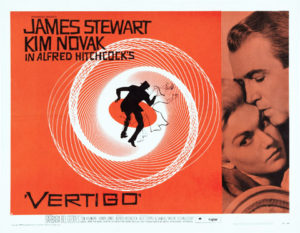 The movie opens with San Francisco police detective “John ‘Scottie’ Ferguson” (James Stewart) hanging off a ledge during a nighttime rooftop chase, his failure to grab the hand of a fellow police officer resulting in his colleague’s death.
The movie opens with San Francisco police detective “John ‘Scottie’ Ferguson” (James Stewart) hanging off a ledge during a nighttime rooftop chase, his failure to grab the hand of a fellow police officer resulting in his colleague’s death.
A few months later, retired from the force due to a now-crippling fear of heights, Scottie is recruited by an old school chum (Tom Elmore) to tail his wife, “Madeleine” (Kim Novak; the quotation marks around her character’s name having a double meaning here) whom the husband ‘believes’ (quotation marks again) is possessed by the tormented spirit of her great-grandmother…
And so begins a fragmented, time-and-space-altering pursuit across the San Francisco Bay area or, possibly more likely, through the deeply disturbed psyche of a tormented individual.
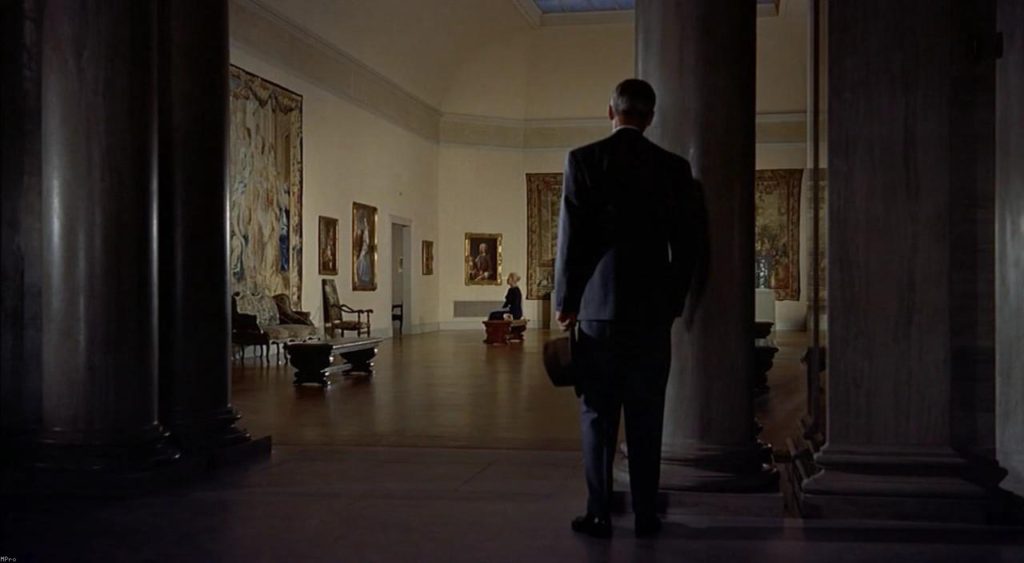
“Here I was born, and there I died. It was only a moment for you; you took no notice.”
Well, can’t say much more without giving away too much, but suffice it to say that if you can follow all that you have a pretty good chance of following the rest of the movie… Or not.
In order to gauge a well-reasoned, common sense reaction to the “dream-like,” “hypnotic,” “powerful” (words critics often employ when describing this movie) goings-on of the Master of Suspense’s most “avant-garde,” “artsy” (other words critics employ to describe Vertigo) entry among his distinguished catalogue of Hollywood thrillers, one should carefully consider what Hitchcock himself referred to in numerous interviews, with a good deal of the director’s trademarked droll irony, as his “old friends, The Plausibles.” Is the combined effect of Robert Burks’ ravishing Technicolor cinematography, Hitch’s usual standard of taut direction, picture postcard-perfect images of San Francisco (in the late ’50s, no less), and, most of all, Bernard Herrman’s intense, brooding, eerie (adjectives simply don’t do it justice) musical score enough to break down a natural resistance to a slight, let’s say, ‘lack’ of good, solid story sense and simple A – B causality?
Alas, for some viewers it will not. (Indeed, “enough plot holes to drive a truck through” may be some viewers’ entirely rational reaction.) This is definitely a opinion I understand and respect, and Sight & Sound magazine’s relatively recent (2012) evaluation of Vertigo as The Greatest Hitchcock Movie—and, indeed, the single greatest movie ever filmed(!)—seems, again, a *slight* exaggeration (and overrating to boot), but personally I’ve always enjoyed and admired the movie on its own terms.
Based on the 1954 French thriller D’entre les morts by crime fiction writers Pierre Boileau and Thomas Narcejac—whose previous Celle qui n’était plus was filmed by director Henri-Georges Clouzot in 1955 as Les Diaboliques (a film whose plot and technique Hitchcock both deeply admired and was bitterly jealous of)—Hitchcock was nowhere more experimental in terms of narrative and film style than the cinematic dreamscape he creates here. Not only inventing/introducing subjective optical effects such as the track-out/zoom-in (to visually simulate Scottie’s fear of heights) and a then-highly sophisticated use of animation and trick photography (Scottie’s spinning green head against a swirling geometric background is a particular stand-out), but the forcefully implausible, almost insistently illogical unfolding of its twisting/turning plot invites its audience to wonder whether the dream-like drama is taking place entirely inside its obsessive, deluded character’s mind. Where do dreams end and reality begin?
So I see Vertigo as a Mood Piece. Either you’re into that deep, dark part in yourself between dream and waking, nightmare and reality—or not. (And you’ve probably got better sense than I have if ‘not.’) I’m calling Vertigo a noir here (and probably a neo-noir) ‘cause it has that same kinda moody, shadow-drenched atmosphere of dread; only this time it’s in blazing Technicolor and the scenery—streets on hills, river bridges, mist-enshrouded cemeteries, forest-y oceanside national parks, stately art museums, and old Spanish Missions—is real pretty; a true feast for the senses in every respect.
Plot be damned!
VI.
SHOOT THE PIANO PLAYER
(1960, France, dir. Francois Truffaut)
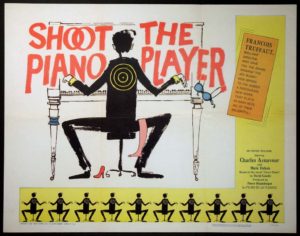 So there’s this guy (Albert Remy) being chased by some crooks (Daniel Boulanger, Pierre Mansard) down a dark street in Paris. The guy turns down an alley and runs smack dab into a lamppost, knocking down an elderly gent who, upon being helped to his feet, randomly regales our man with a story of falling in, then out, then back in love with his wife of 40 years. (Ah, Paris!) Suddenly recalling he’s being chased by these, y’know, gangsters with guns and all, the guy bids the old man ‘adieu’ and jolts down another random street, passing a local dive where he spots a poster of a familiar figure playing the piano…
So there’s this guy (Albert Remy) being chased by some crooks (Daniel Boulanger, Pierre Mansard) down a dark street in Paris. The guy turns down an alley and runs smack dab into a lamppost, knocking down an elderly gent who, upon being helped to his feet, randomly regales our man with a story of falling in, then out, then back in love with his wife of 40 years. (Ah, Paris!) Suddenly recalling he’s being chased by these, y’know, gangsters with guns and all, the guy bids the old man ‘adieu’ and jolts down another random street, passing a local dive where he spots a poster of a familiar figure playing the piano…
So the guy enters the bar, where we learn his name is “Chico” and that the guy playing the piano is his long-lost brother “Edouard” (Charles Aznavour) who, for reasons yet unclear, now goes by the name of “Charlie.” But the family reunion is cut short when Chico again suddenly recalls he’s being chased by gangsters with guns (oh yeah, those guys) and Charlie/Edouard and his barmaid friend, “Lena,” (Marie Dubois) help Chico escape out the back door, tipping over a couple crates filled with beer bottles behind him to cut short the gangsters’ pursuit…
And thus the piano player becomes their new target!
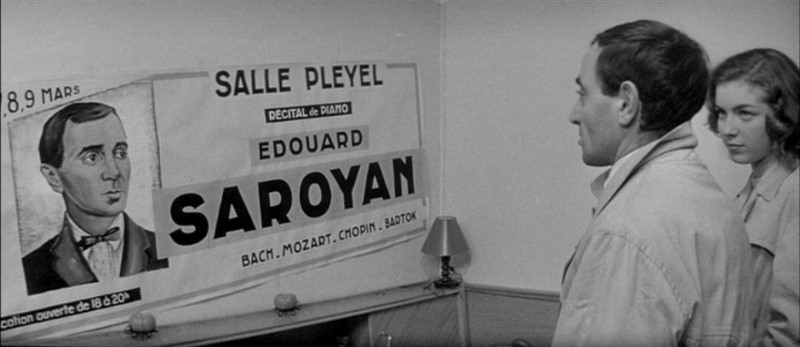
“My pop used to say, ‘If someone knocks, assume it’s a murderer. If it’s just a robber, you’ll be happy.’”
Former critic turned film director Francois Truffaut’s second full-length feature, based on the hardboiled novel Down There by David Goodis, is a breezy, jazzy riff on American crime melodramas and a key work of the Nouvelle Vague (“French New Wave”). As critics, Truffaut and his cohorts at Les Cahiers du Cinema—or “The Film Notebook,” a major film periodical founded by influential film critic, Andre Bazin—popularized the term “film noir” to describe the dark and sinister urban thrillers major and not-so-major Hollywood studios churned out during the ’40s and ’50s. We—and by ‘we’ I mean American audiences and film producers alike—had just thought of ‘em as “B pictures”; these French critics turned filmmakers posited our own shadowy visions of terror, corruption, and dread as “art.”
Ok, so that’s the dry ‘academic’ side of things… What I’d really like to get at is how truly fun this movie is. A movie that, say, full stops in the middle of a chase scene to deliver a breathtakingly hilarious disquisition on L’amour, or gives us a momentary pang of pity for a thoroughly unpleasant turncoat/attempted murderer because he “has no luck with women,” earns points in my ‘book’—Le Cinephile, or “The Film Enthusiast”—for quirky narrative invention and for pure cinematic charm. A self-admitted “grab bag” of slapstick and screwball silliness–by way of post-noir tragedy and crushing fate—this is, for me, the very best kind of movie: a movie for people who love movies.
Post-Noir: City of Noir
“This is the city.” This line of opening narration from the long-running radio and television series Dragnet (radio: 1949 – 1957; TV: 1951 – 1959, 1967 – 1970), spoken in the dry, terse monotone of starring actor and head writer Jack Webb, as dedicated Los Angeles police officer “Sgt. Joe Friday,” provides the basis for our final selections on the Classic Hollywood genre of film noir.
The City, or perhaps I should say “the setting,” is the one inescapable element, the unifying element of time and place, from which any noir worth its salt gains its power and relevance.
Whether it’s New York, San Francisco, London—or the shattered, shelled-out ruins of post-war, occupied Vienna—the character of a noir’s nighttime, after-dark setting—its roads and landmarks; its off-the-beaten path locations and secret places—imparts atmosphere and context to the psychodrama of its flawed, all-to-human protagonists.
For our final entries, then, following the example set by pioneering crime fiction writer Raymond Chandler and his 1939 novel The Big Sleep—the first novel to ‘star’ tarnished knight-like private detective, “Philip Marlowe”—we’ll serve up a few further examples of what many have referred to, along with Sgt. Joe Friday above, as THE “City of Noir”: Los Angeles, California.
VII.
CHINATOWN
(1974, Paramount, dir. Roman Polanski)
 Los Angeles, 1937. Private detective “J.J. Gittes” (Jack Nicholson) makes a stylish living working the Hollywood scene. Divorce cases, mostly, but also helping the occasional celebrity—signed photographs of grateful movie stars like Adolph Menjou and Gloria Swanson adorn his office wall—to avoid the ever-looming specter of bad publicity.
Los Angeles, 1937. Private detective “J.J. Gittes” (Jack Nicholson) makes a stylish living working the Hollywood scene. Divorce cases, mostly, but also helping the occasional celebrity—signed photographs of grateful movie stars like Adolph Menjou and Gloria Swanson adorn his office wall—to avoid the ever-looming specter of bad publicity.
Well, in a town where good or bad press can make or break a career, Jake’s reputation as a “rough, but reliable” P.I. is at stake after a society woman (Diane Ladd) hires him to tail her philandering husband. “Hollis Mulwray” (Darrell Zwerling), who along with industrialist “Noah Cross” (John Huston) once owned the entire freshwater supply of Southern California, is now chief water engineer of L.A. County, and the “love nest” Gittes uncovers with Mulwray and a young woman not his wife (Belinda Palmer) is soon splashed all over the front pages. Which brings Gittes to the attention of the REAL “Mrs. Mulwray” (Faye Dunaway), who never met Mr. Gittes and indeed never hired the man to take photos of her husband and his young ‘lover’…
Realizing he’s been played for a chump, Gittes figures whoever set him up is also after Mulwray–taking heat himself recently after refusing to build a controversial dam just north of L.A.–but before our intrepid gumshoe can locate him, the water commissioner turns up drowned, in a freshwater reservoir, with saltwater in his lungs, in the middle of a drought.
Only in L.A.!
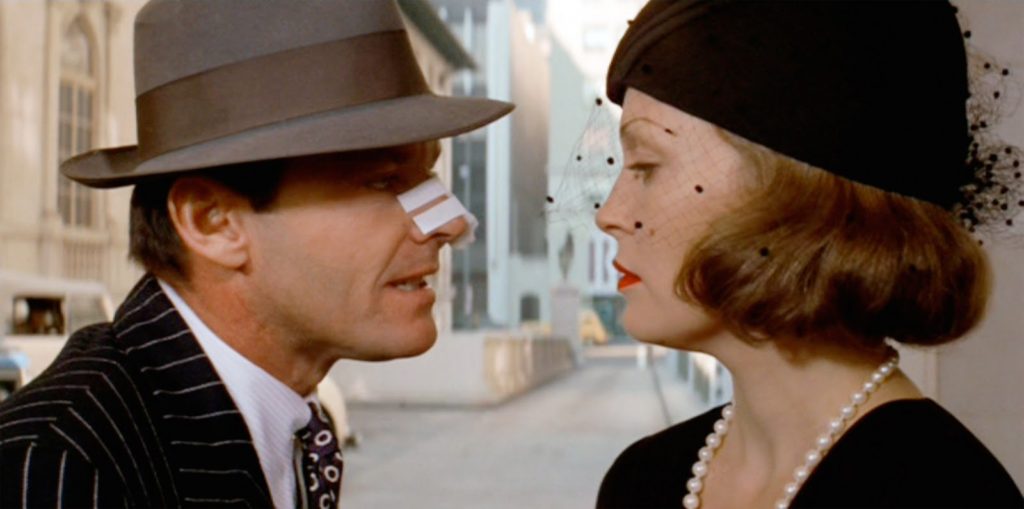
“All right, Curly, enough’s enough. You can’t eat the Venetian blinds. I just had them installed on Wednesday.”
“Forget it, Jake. It’s Chinatown.”
What can I say? Chinatown is quite simply the ne plus ultra, the zenith, the very apogee of neo-noir. Mixing the hardboiled romanticism of Chandler, Hammett et al. with a revisionist slant on real Southern California history—read up on “William Mulholland,” “Owens Valley,” and the “California Water Wars” for a bit of an eye-opener—this is one of those cases where fiction and reality blend so seamlessly that, as late critic Roger Ebert observed, you’ll never be able to take a drive in, say, Beverly Hills—watching those sprinklers endlessly sprinkling over those well-watered lawns—without thinking of this movie. As movie villain Noah Cross—played with dastardly relish by the director of the very first noir, The Maltese Falcon, Mr. John Huston himself—puts it, “The Future, Mr. Gittes! The Future!” (A statement which, unfortunately, only makes sense AFTER you’ve seen this movie. And, I should add, it certainly doesn’t hurt to see The Maltese Falcon either.)
It’s also accomplished filmmaking on every level. I think I’d go so far as to call it THE perfect movie. Roman Polanski’s off-kilter direction, Robert Towne’s novel-like script, John A. Alonzo’s alternately documentary-like and classically-assured cinematography, Jerry Goldsmith’s evocative and eerie scoring—heck, even the overweening chutzpah of egomaniacal producer Robert Evans for even scaling ambition on this grand of a scale—all serve beautifully to put Jack Nicholson through the cinematic wringer. Making Jack—possessor of “the least reassuring smile in movie history” (Ebert again)—a dapperly-dressed Private Investigator in the trenchcoat-wearing vein of a Humphrey Bogart or Robert Mitchum was inspired; making his character go through half the movie wearing a bandage over his nose was a stroke of pure genius.
::SPOILER:: I figure I probably *should* address the climactic moment of the movie—in which Faye Dunaway’s character “Evelyn Mulwray,” daughter of the evil industrialist and widow of the conscientious public officer, has the “truth” about her late husband’s apparent ‘lover’ literally beaten out of her by Gittes. Yes, it’s a brutal scene. But I can only say that as a metaphor for the way business is conducted in this country, and the manner in which public officials have overwhelmingly treated its natural resources since, oh, let’s say about 1776 give-or-take, it is—like the movie and everything about it—absolutely perfect. But, paraphrasing a later L.A. neo-noir classic (soon to be profiled below), that’s “y’know, just, like, [an] opinion, man.”
VIII.
L.A. CONFIDENTIAL
(1997, Regency Enterprises, dir. Curtis Hanson)
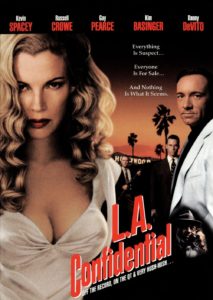 HUSH-HUSH Magazine, January 1955:
HUSH-HUSH Magazine, January 1955:
Welcome to Los Angeles, City of the Future! The orange groves lie bulldozed, the streets are lined with tract housing, the Hollywood Freeway stretches straight and pure from the Valley to the Downtown, and the Criminal Courts Building stands sentinel like a tower of justice over it all. Evil gangster Meyer Harris Cohen—Mickey C (Paul Guilfoyle) to his fans—is behind bars, serving 5-10 for tax evasion, and on TV, “Badge of Honor” star Brett Chase (Matt McCoy) works his wonders to behold in honor of this city and the stainless reputation of its police force. Yes, friends, all is copacetic in the City of Angels!
Or is it? ITEM: Who killed Sid Hudgens (Danny Devito)? We now know that the former editor of this illustrious publication was fatally slashed, not in his office as he was later found, but rather in a little sleazebucket motel, The Victory, whose woeful whereabouts and sin-tillating significance remained unmarked till a cop shootout claiming the lives of 14 officers—including hero cop Capt. Dudley Smith(James Cromwell)—transpired at that very spot a scant few days after the Sidster’s death.
Cops killing cops! And only two of ‘em, Det. Lt. (now Captain) Edmund Exley (Guy Pearce) andOfficer (now retired) Wendell ‘Bud’ White (Russell Crowe), were left standing when the smoke cleared. What goings-on are these?
15 months have passed without justice being done, and the murderer(s) of Sid Hudgens remain at large. (Non-)Coincidentally, Hudgens’ close associate on the LAPD, Det. Sgt. John ‘Hollywood Jack’Vincennes (Kevin Spacey) has also been ‘missing’ for exactly the same time… What had the Sidster and Hollywood Jack uncovered?
Dunno yet, hepcats, but when your first source for prime sin-nuendo strikes sin-tillating pay dirt again you will, as always, be first to know. And that, dear reader, is, as always: off the record, on the QT, and very HUSH-HUSH.
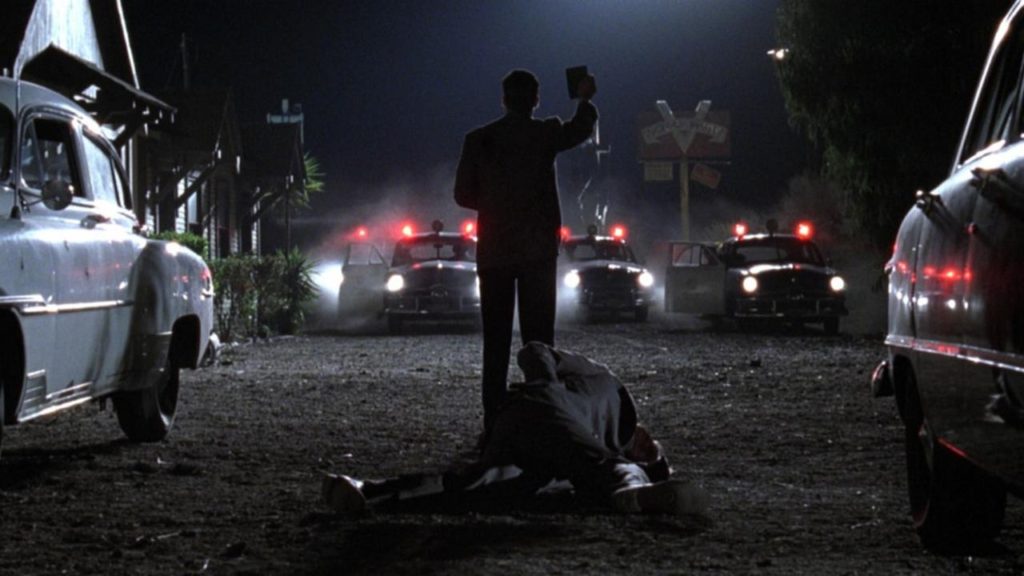
“Hold up your badge, so they’ll know you’re a police officer.”
The epic crime story of the making of modern-day L.A., based on the sprawling, ultra-hardboiled novel by James Ellroy, is in my humble opinion the best movie made in the past 20 years. Curtis Hanson’s crisp direction, Brian Helgeland’s literate script, Dante Spinotti’s sunbaked cinematography, composer Jerry Goldsmith’s romantically-charged post-Chinatown score, and production designer Jeannine Oppewall’s magnificent recreation of early ’50s LA are triumphs in every respect.
The source music—from Dean Martin to Peggy Lee—is entirely appropriate and the casting of two then-unknown Australians in the leading roles—Russell Crowe and Guy Pearce—is inspired. All in all, the rare movie that succeeds on nearly every level, the rare period movie that seamlessly revives the ghost of the past, and finally the rare period crime movie in which the action is not only necessary to the plot, but retains the urgency of the time it’s depicting.
What more can I say? This is classy filmmaking at its classiest. Heck, grasshoppers and dopefiends, I’m still reelin’ from having had opportunity to dope out a fake ’50s tabloid feature for my plot description hangin’ just over. Yeah, I really was born about 5 decades too late… And once again, dear readers, that’s off the record, on the QT, and very HUSH-HUSH.
IX.
THE BIG LEBOWSKI
(1998, Working Title Films, dir(s). Joel & Ethan Coen)
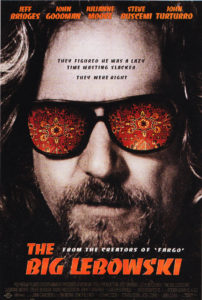 More and more o’ late, seems lotsa folks’ve been askin’ me (Sam Elliott) ‘bout what happened to The Dude (Jeff Bridges). Well, not being much of a man for lookin’ back—Westward the Wagons and so forth—I feel a certain, dunno, reluctance to further expound on the man and his subsequent exploits.
More and more o’ late, seems lotsa folks’ve been askin’ me (Sam Elliott) ‘bout what happened to The Dude (Jeff Bridges). Well, not being much of a man for lookin’ back—Westward the Wagons and so forth—I feel a certain, dunno, reluctance to further expound on the man and his subsequent exploits.
But there’s always somethin’ to come along and change a man’s mind and that particular somethin’ came just a few days ago. ‘Bout 3 or 4 miles from The Ol’ Homestead—Downtown, that is—I happened to witness a, let’s call it, traffic altercation, in which the injured party, let’s call ‘im, leaped out of his car with a tire iron to-hand and used—re-used, let’s say—a certain colorful expression I recognized having first barked forth, repeatedly, from the spacious lungs of The Dude’s comrade-in-arms, Walter Sobchak (John Goodman).
Now, what’s permissible in war ain’t nearly as excusable in civilian life—‘specially the use of not one, but two cuss words in the same utterance—and to compare a little fender-bender in a backwoods burg with driving all the way out to North Hollywood (near the In ‘N Out Burger) to be stonewalled by some little varmint who left his homework in your stolen mode of transportation—be it horse OR car—ain’t no comparison ‘tall. (Suffice it to say, I did, uh, intervene before the injured party took that tire iron to the injuring party’s windshield.)
After the dust, um, re-settled to the satisfaction of all parties, it came to mind I’d been hearing the words of The Dude, Walter, Donny (Steve Buscemi), and the rest used In Vain on many an occasion of late. Seems there’s even this sorta imaginary space—floatin’ somewhere up there in the aether, and comin’ down to earth through these pint-size thingamajigs—where folks trade on wit not their own like no-goodnecks ‘round these parts passin’ off painted pintos at a pony show.
But here I am, ramblin’ again. S’pose we’ll have to save The Adventure of The Dude and The Little Lebowski for another time, mebbe… In the meantime, we can take comfort in that The Dude, as always, Abides. Still takin’ it easy for the rest of us.
Catch ya on down the trail, pardners.
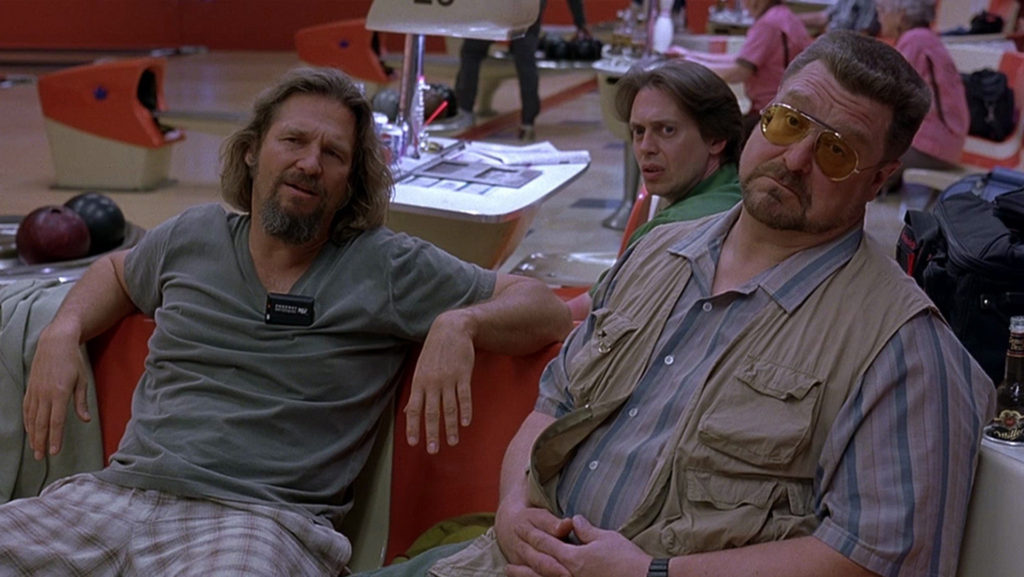
“Is this a… What day is this?”
Well, again, what can I say that hasn’t been said before, and much, much better than I could say it? The story of three Hollywood misfits who get caught in the whirlwind of rug-pissing, White Russians, acid flashbacks, wheelchair-bound “achievement,” trophy wives (using the parlance of our times), fake kidnapping, German-accented nihilism, “strongly vaginal” avant-garde art, porn palaces built in “reactionary” beach communities, and bowling (most of all, bowling) has by this point passed into legend.
But what most don’t realize, maybe, is that The Big Lebowski is in fact a cleverly disguised L.A. Noir, firmly in the sunbaked tradition of The Big Sleep (1946), Chinatown, and L.A. Confidential. In fact, Lebowski could serve quite well as coda to an unofficial trilogy comprising the latter two movies—the making/unmaking of modern-day L.A., as exposed in both the ’30s and ’50s—continuing the story up to the smog-covered, burnt-out wasteland we see before us today… But, y’know, with bowling.
…
All things must end, as must this series of write-ups, but it’s no reason to despair. (As if!) The Dude Abides. And as long as there’s a Ralphs nearby, an In ‘N Out Burger on Radford, or the neon-glow of bowling alleys lining the Sunset Strip—and, o’course, a “little Lebowski on the way”— there will always be a place for The Dude, Walter, and even poor Donny (Try watching the movie sometime and downing a White Russian every time he’s profanely-informed by Walter that he’s “out of [his] element!” If you don’t die of alcohol poisoning, you’ll certainly become lactose intolerant.) Avenging “micturated upon” rugs, spotting ringers for ringers, drawing firearms during league play: a trio of Guardian Angels in the City Of takin’ it easy for the rest of us.
And they bowl.


